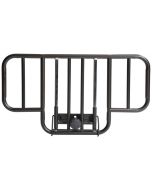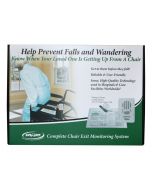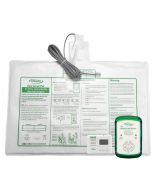
There are multiple factors that contribute to an adult falling out of bed. But no matter what the cause or causes may be, there are precautions that can be taken to help prevent injuries from these type of falls.
There are 5 products we can recommend for fall prevention from beds for older adults. In this article we’ll go over each one of these, their pros and cons to help you decide which one(s) may be helpful for you and/or your senior loved one.
We used to work with Physical Therapists on a fall risk assessment of our patients to determine the level of cognitive and physical abilities the patient was able to perform as well as to assess the environment (their bedroom) to see what would be needed to make falling out of bed as preventable as possible.
For anyone who is dealing with the problem of an elderly person falling out of bed while sleeping or while they are attempting to get up, know that there are some things you can do to protect and try to stop your geriatric loved one(s) from these type of falls.
What you may end up using will depend on the physical and cognitive deficit(s) they are dealing with.
1. Bed Rails For Seniors
Bed rails are usually what most people immediately think of when it comes to protection from falling out of bed. And they are a very good option, but again, not for everyone.
Patients can injure themselves as they try to get out of the bed by sliding down to the end of the bed, or trying to climb over the bed rail or getting their arm or leg caught in the bed rail.
But, having said that – if you feel it’s an option for your parent, then let me give you some information on the different types of bed rails available.
Transfer Bed Rails (aka Assist Bed Rails)
Transfer bed rails are the smallest and least intrusive type of rails. Their main purpose is really to make transferring into and out of bed easier for both the elderly person and the caregiver.
They work best with seniors who are cognitively aware of their environment and are the least likely to fall out of bed.
Standard Bed Safety Rails
The standard bed rails that most people think of are longer but they don’t fit the entire length of the bed. Most hospital beds come equipped with these type of rails.
But you don’t necessarily have to get a hospital bed, you can add these type of safety rails to your existing bed.
But for a low price, it does fold which makes it much easier for your mom or dad to get in and out of the bed.
The only precaution we would give with these types of add-on rails is that when they are folded down – they do tend to “stick out” from the bed frame. As a result, when your elderly parent swings their legs over to the side of the bed where the folded rail is, they may bruise or cut their skin on the folded railing.
Full Length Side Rails
A third type of bed rail is the full length version which again, you can install onto a standard bed.
Most of them mounts to the fabric spring of the bed and is secured with two spring-loaded cross bars.
Again, because are constructed with bars, be aware that if your parent is able to understand that they are not to attempt getting out of the bed while this safety rail is up. You don’t want them getting caught between the bars and injuring themselves.
2. Platform or Low Beds
Best Bed Height For Seniors
The general rule of thumb to the best bed height is 20 – 23 inches from the floor to the top of the mattress. BUT the truth is, that these recommendations are based on wheelchair heights, not necessarily that of older adults.
For this reason we believe that there is no “best bed height for seniors.” Instead, what we say is that the height of the bed is relative to the person who is using that bed. And note that this changes as the person gets older.
Best Bed For Elderly Persons
So, the “best bed” for an elderly person should accommodate their height and a mattress that is most comfortable for them.
But having said that – Platform Beds are one type of bed that can be very well suited for older adults.
Pros And Cons Of Platform Beds For Seniors
The benefit of a platform or a low bed is that if a fall occurs, it’s not a far distance to the ground which minimizes injury. You can also add a bedside fall mat on the floor beside the bed for extra precaution.
Another benefit is that they don’t require a box spring giving you a savings if you have to replace the mattress.
The downside of using these types of beds is that because the mattress sits on slats, it tends to be a very firm type of support. If your loved one sleeps on their side, it may be uncomfortable.
Another issue with low beds is that depending on the height of your loved one, it may be difficult for them to get up out of bed (it may also be difficult for you to get them out of bed). So, that’s definitely something to consider.
But overall, lowering the height of the bed is an excellent solution for anyone who is a fall risk.
One other note here about beds. We would recommend to position the bed so that one side of the bed is up against the wall. This will create a barrier on one side.
About Pivot Beds
Another Option are Pivot Turning Beds – which mechanically turns and bends the mattress making it easier to get in and out of bed.
…the goal is to move them into a sitting-on-the-edge-of-the-bed position using a remote control mechanism. This makes it possible for a person lying in the bed to move it into a sitting position that can help them safely slide off the bed.
3. Posey Beds
A solution that works for some (not for all) are Posey Beds. These beds are designed specifically for people who are at a very high risk of serious injury from falling out of bed.
This usually means anyone who suffers from severe dementia usually coupled with REM Behavior Disorder or other similar diagnosis which causes them to kick, punch and thrash about in their sleep (which of course cause cause them to fall out of bed).
A Posey Bed is most often used in hospitals, senior living facilities and nursing homes.
Not all seniors would be comfortable in a Posey Bed – if they are claustrophobic in any way – they may have a difficult time laying down in something that has 4 sides and a top. Of course, the screened areas can be zipped off, leaving it more open.
It’s a decision that you will have to make with your doctor and any other caregivers working with your elderly loved one(s).
4. Floor Fall Mats
If you can’t invest in a low bed and your senior parent will be using a standard height bed then using a twin size mattress or floor fall mat on the side of the bed is a must. This will help to cushion the fall and hopefully prevent injury or at least minimize it.
If your senior loved one gets up in the middle of the night for whatever reason a mattress may not be a viable option because stepping on that type of surface may cause them to fall.
Note: IF the elderly person DOES tend to get up often during the night – and you want to make that task safer for them – we would recommend the Smart Caregiver® Floor Mat It’s a flat mat that can be placed on the floor, by the bed. It plugs into an outlet and when stepped on, it can turn on the light in the room AND notify you (the caregiver) that your elderly loved one has gotten up. Of course, if they fall onto the mat – it will notify you as well.
A fall mat is not as thick as a twin size mattress would be but it’s easier to stand on when the person your senior loved one gets out of bed.
Of course, you can also use a thick mattress topper here as well (they can all be cut to size) but again, it may be difficult for your elderly loved one to stand on so you will have to judge which option would work best for you.
And keep in mind, that as your senior loved one ages, their condition will likely only worsen. So, they may be able to stand on a twin mattress today, but next month, perhaps not.
5. Bed Alarms
Today, you can purchase bed alarms for your own home and we think that is just amazing. Bed alarms are inexpensive and a fantastic way for you to “monitor” your senior loved one.
One that we recommend is the bed alarm made by Smart Caregiver. It’s wireless and cord free making it as safe as possible (no cords to get tangled in).
The bed alarm is a pad that is placed on top of the mattress, under the fitted sheets. It is placed directly under the shoulder blades of the person laying on the bed.
Once the person in the bed starts to get up, the pad sets off the alarm.
Since these bed alarms do not come with 2 alarms (one in their room and one for your room) I would recommend to use a baby monitor as well so that you can hear the bed alarm go off. This would work well especially if your bedroom is on a separate floor.
You may have to try several options before you find the one or combination that works for you. And please be aware that as your loved one ages, you may have to change your “formula”.
If your senior suffers from dementia or alzheimers he/she may have a difficult time remembering any “safety rules” you try to implement. They may also be unable to comprehend what you are trying to tell them. In this case – it would be safer to lower their bed.If you cannot lower the bed, I would recommend to place a twin size mattress on the side of the bed to cushion a possible fall. There are mats available just for this purpose if you wish to purchase any of them.
Another bed option that may be viable is a Posey Bed. More about these beds below.
You can add bed rails to any kind of bed as well.
Bedside wedges, rolls and bolsters are another solution that may be useful.
Some caregivers have had success using pool noodles on either side of the bed.
Bed alarms are another tool that you can use. This will alert you if your senior loved one attempts to get out of bed.




Comments
Leave A Reply
Your email address will not be published.